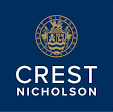Related Research Articles
Heidelberg Materials UK is a British-based building materials company, headquartered in Maidenhead. Previously known as Hanson UK, the company has been a subsidiary of the German company HeidelbergCement since August 2007, and was formerly listed on the London Stock Exchange and a constituent of the FTSE 100 Index.

Barratt Developments plc is one of the largest residential property development companies in the United Kingdom operating across England, Wales and Scotland. It was founded in 1958 as Greensitt Bros., but control was later assumed by Sir Lawrie Barratt. It was originally based in Newcastle upon Tyne but is now located at David Wilson's former offices in Coalville, Leicestershire. It has been listed on the London Stock Exchange since 1968, and is a constituent of the FTSE 100 Index.
Bellway p l c is a residential property developer and housebuilder based in Newcastle upon Tyne, England. It is listed on the London Stock Exchange and is a constituent of the FTSE 250 Index.
Persimmon plc is a British housebuilding company, headquartered in York, England. The company is named after a horse which won the 1896 Derby and St. Leger for the Prince of Wales. It is listed on the London Stock Exchange and is a constituent of the FTSE 100 Index.

Crest Nicholson is a British housebuilding company based in Weybridge, Surrey. It is listed on the London Stock Exchange and is a constituent of the FTSE 250 Index.
Westbury plc was a British housebuilding company based in Cheltenham, Gloucestershire. It was listed on the London Stock Exchange and was a constituent of the FTSE 250 Index but was acquired by Persimmon plc in 2005.

Taylor Woodrow was one of the largest housebuilding and general construction companies in Britain. It was listed on the London Stock Exchange and was a constituent of the FTSE 100 Index until its merger with rival George Wimpey to create Taylor Wimpey on 3 July 2007.

Wilson Bowden plc was a British housebuilding and general construction company headquartered in Coalville in central England.
Redrow plc is one of the largest British housebuilders with a network of 12 operational divisions across the UK. It is based in Flintshire, Wales and employs 2,300 people. It is listed on the London Stock Exchange and is currently a constituent of the FTSE 250 Index.

Mowlem was one of the largest construction and civil engineering companies in the United Kingdom. Carillion bought the firm in 2006.

Trafalgar House was a British conglomerate with interests in property investment, property development, engineering, construction, shipping, hotels, energy and publishing. It was listed on the London Stock Exchange and was a constituent of the FTSE 100 Index but eventually floundered in the mid-1990s.
Crosby Homes was a major British residential housebuilding business. It was acquired by Lendlease in 2005.
Tarmac Group Limited was a British building materials company headquartered in Wolverhampton, United Kingdom. It produced road surfacing and heavy building materials including aggregates, concrete, cement and lime, as well as operating as a road construction and maintenance subcontractor.

Kier Group plc is a British construction, services and property group active in building and civil engineering, support services, and the Private Finance Initiative.

Morgan Sindall Group plc is a leading British Construction & Regeneration group, headquartered in London employing around 6,700 employees and operating in the public, regulated and private sectors. It reports through six divisions of Construction & Infrastructure, Fit Out, Property Services, Partnership Housing, Urban Regeneration and Investments. It is listed on the London Stock Exchange and is a constituent of the FTSE 250 Index.

Mouchel Group, originally known as L. G. Mouchel & Partners Ltd, was an infrastructure and business services company headquartered in Woking, United Kingdom. It provided advisory, design, project delivery and managed services associated with infrastructure and business services across the highways and transportation, local government, emergency services, property, health, education and utility markets across the world.
Miller Homes Limited is a housebuilder based in the United Kingdom.
Henry Boot PLC is a British property development business, listed on the London Stock Exchange. It was floated on the London Stock Exchange in 1919, becoming the first quoted housebuilder. Between the wars, Henry Boot built more houses than any other company. The company remains a significant construction and property management company operating in the UK.
Ideal Homes was a British housebuilder.
Charles Church Developments Limited, trading as Charles Church, is a British upmarket housebuilding company which is headquartered in York, England. The company is named after its co-founder Charles JG Church who established the business in 1965. After a series of complex restructurings and takeovers, the company has been a subsidiary of Persimmon plc since 2001.
References
- 1 2 3 4 C.H.Beazer (Holdings) Prospectus, July 1973
- 1 2 Cyril Beazer, Random Reflections of a West Country Master Craftsman (1981)
- 1 2 3 4 5 Wellings, Fred: Dictionary of British Housebuilders (2006) Troubador. ISBN 978-0-9552965-0-5
- ↑ "The History of F. Pratten Co Ltd talk on Thursday". Somerset Guardian. Retrieved 28 March 2016.[ permanent dead link ]
- ↑ Prospectus March 1994
- ↑ "Beazer pays £35.7m for Charles Church". cconstructionnews.co.uk. Retrieved 6 June 2020.
- ↑ "Eager Beazer puts faith in Church". independent.co.uk. Retrieved 6 June 2020.
- ↑ Acquisition Document February 2001